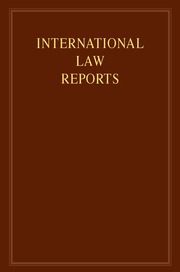No CrossRef data available.
Article contents
Thomas v. Mowbray and Others
Published online by Cambridge University Press: 01 January 2021
Abstract
Governments — Separation of powers — Roles and responsibilities of executive, legislative and judicial branches of government — Rule of law — Policy — “The chameleon doctrine”
Jurisdiction — Original jurisdiction of High Court — Issuing courts — Chapter III courts — Validity of federal legislative provisions — Australian Constitution — Defence power — Whether defence power purposive — Whether “defence” limited to defence against external threats or threats from foreign nations — Whether “defence” limited to defence of community and several states as bodies politic — External affairs power — Relevance of combating terrorism to comity between nations — Referral power — Implied power to protect nation — Presumption against alteration of common law rights — Constitutional facts — Consideration of policy in judicial determinations — Exercise of judicial power — Judicial controversy — Determination of rights or obligations — Requirement of discernible standards and norms — Non-justiciability — Burden of proof — Balancing exercises — Ex parte proceedings
Relationship of international law and municipal law — Criminal Code (Cth) — Part 5.3 — Division 104 — Section 104 — Section 105 — Section 51(xxix) of Australian Constitution — Interpretation of Australian law — International law ratified by and binding on Australia — International Covenant on Civil and Political Rights, 1966 — United Nations Security Council Resolution 1373 (2001) — Extent to which Security Council Resolutions binding on Australia — Whether Division 104 of Criminal Code validly enacted under external affairs power — Promotion of comity with foreign governments — Preservation of integrity of foreign States
Terrorism — Criminal Code (Cth) — Interpretation and application — Part 5.3 — Division 104 — Section 104 — Section 105 — Definition of “terrorist act” — Interim control orders — Obligations, prohibitions and restrictions upon an individual to protect public from a terrorist act — Public interest — Whether obligations, prohibitions and restrictions “reasonably necessary” and “reasonably appropriate and adapted” to protect public — Section 51(vi) of Australian Constitution — Whether Division 104 of Criminal Code validly enacted under defence power
War and armed conflict — Armed conflict — Terrorism — Applicability of defence powers to threat posed by terrorism — The law of Australia
Keywords
- Type
- Case Report
- Information
- Copyright
- © Cambridge University Press 2016


